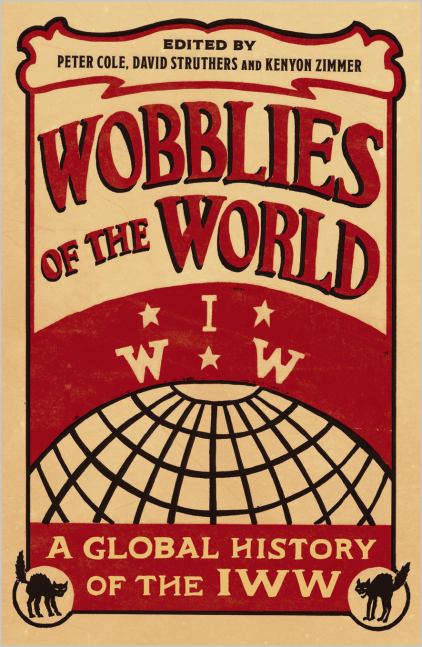
The IWW is sometimes thought of as an American organization since it was founded in Chicago in 1905 and saw its greatest activity in the United States. That assumption is challenged in “Wobblies of the World: A Global History of the IWW,” a collection of essays from 20 scholars first published in 2017 and edited by Peter Cole, David Struthers and Kenyon Zimmer. Unlike most previous scholarship on IWW history, “Wobblies of the World” seeks out non-English-language sources and attempts to, as the editors put it in the introduction, “begin a long-overdue conversation about the IWW as a global phenomenon.” We caught up with Cole, a history professor at Western Illinois University, to learn more about the collection, which has just been published in French translation and will be the subject of an upcoming online book launch in Montreal, Quebec, on Dec., 9, 2021. The conversation has been edited for length and clarity.
Industrial Worker: An essay in this book tells the story of how the IWW was nearly named the Industrial Union of America before a group of anarchist delegates fought for the more expansive name, the Industrial Workers of the World. Why was international solidarity such an important part of the IWW’s revolutionary mission?
Peter Cole: In 1905, capitalism was already a global system. Although it was very uneven and developing in different parts of the world, by the early 20th century the United States was already the great industrial power in terms of production. Americans, but also people in other parts of the Americas as well as in Europe and other parts of the world, already saw this system as an international one. Socialists prior to the IWW already saw the international perspective as vital. The IWW is original in many ways, but in many other ways they’re actually heirs to a tradition of socialists. I would include anarchism within the socialist tradition — skeptical of state power, but nevertheless very much anti-capitalist.
The U.S. is also particular in that a lot of people from many other parts of the world were coming into the U.S. but also often leaving. About one in four immigrants to the U.S. actually returned to their home countries prior to World War One. So when some people proposed the name Industrial Union of America, which is clearly an attempt to counter the American Federation of Labor, the craft union model, it is noteworthy that anarchists, including anarchists from Canada, were among those who were pushing for a more expansive name for the organization. Lucy Parsons famously invoked the Russian Revolution of 1905 — the failed Russian Revolution — at the founding convention. A lot of these people were global in their thought, and some were migrants themselves.
In the introduction you and your co-editors write, “The IWW, from its inception, committed itself to organizing all workers regardless of their ethnic, national, racial, or gender identities.” This was at a time in the early 20th century when the AFL and even some socialist organizations were excluding people of color from membership. How were the anti-racist efforts of the IWW tied to the union’s commitment to internationalism?
I think the IWW needs to be commended for their ideological commitments. But then the question becomes: How did they operate in practice? And I think that the evidence is generally in favor of the IWW in terms of trying to operationalize its values. That’s not easily done sometimes. But whether it was in the nineteen-teens when the IWW was organizing farm workers in California, the largest agricultural producer in the country, where there were dozens of ethnic and linguistic groups working in the fields. Or whether it was organizing on the Philadelphia waterfront where IWW members included the native-born and immigrant, white and black, Protestant and Catholic and Jewish, with no single group making up the majority. You had this multi-ethnic, multiracial workforce.
I always like to point out the example of New Zealand, where a Wobbly — who had joined the IWW in the U.S. and then moved back to his home country of New Zealand — ended up bringing the IWW with him. Some of these New Zealand Wobblies, most of whom were of Irish and English descent or were immigrants from those countries, organized Maoris. The IWW was the first majority-white union to organize Indigenous people, famously having a column in their newspaper that was written in Maori.
The book shows us how international, anti-capitalist organizing and anti-colonial struggles influenced the IWW and vice versa, and Wobblies of the World is packed with fascinating historical gems. What were some of the most surprising things you learned while editing it?
I love Kevan Antonio Aguilar’s chapter on Tampico, Mexico, showing how the IWW often worked with other organizations — anarchists but even communists — during the last phases of the Mexican Revolution. Tampico was the largest export port for petroleum.
I really also like Tariq Khan’s chapter on South Asian workers in the Pacific Northwest. It was a very small group at that time of immigrants from what now is primarily India, who were often just called Hindus regardless of their religion or in fact what colony they might have come from. It was in the early 1920s that the U.S. Supreme Court ruled that basically Hindus, and by extension all other Asians, could never assimilate and therefore could never become citizens. By contrast, the IWW saw these people as workers. They continued to reject the prejudices that many other workers and employers had. And some of these people brought their IWW ideas with them back into the anti-colonial movements in South Asia. I really enjoy and appreciate that chapter because it’s unusual, and I actually didn’t know anything about that history myself until Tariq brought it to our attention.
Interested in learning more? Pick Up Your Copy of Wobblies of the World At Our Shop
